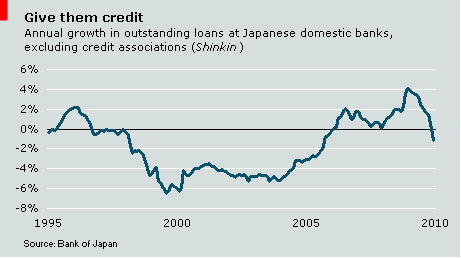You are currently browsing the tag archive for the ‘Japan’ tag.
After a brief growth spurt, bank lending in the US shrank in April and May, according to the latest data from the Federal Reserve. As Bloomberg points out, banks’ appetite for government bonds has remained relatively robust since the onset of the financial crisis. American banks now hold almost US$1.7trn in treasuries and related government debt, with holdings growing by an 11-12% annual clip so far this year, despite miserly yields.
The situation at Japanese banks looks eerily similar. Funds are being recycled into government bonds instead of loans, with year-on-year credit in a seemingly permanent state of contraction. The Economist Intelligence Unit does not expect America to experience a protracted slump like the one that has dogged Japan since its spectacular asset-price bubble burst in early 1990s. Still, there are enough similarities in some metrics to cause discomfort.
Encouragingly, deposits at American and Japanese banks are at or near record highs. This will please regulators, who are urging banks to avoid flightier wholesale sources of funding. But until these funds are put to more productive use than stockpiling low-yielding government bonds, nobody will be truly happy.
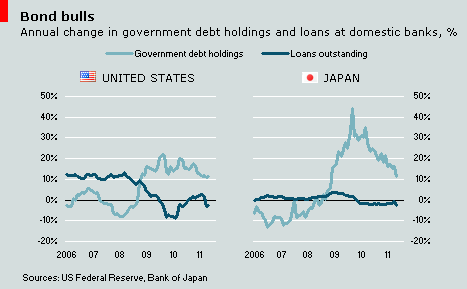
The Economist Intelligence Unit’s latest world economic outlook (free registration required) is largely unchanged from last month, with global GDP growth (at PPP) forecast to reach 4.3% this year.
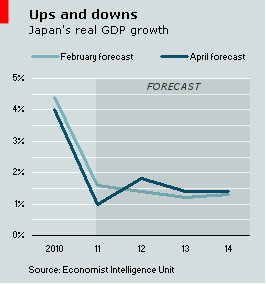
The biggest change to our forecast, unsurprisingly, is to the forecast for disaster-ravaged Japan. We now expect Japan to grow by 1% this year, down from 1.6% before the earthquake and tsunami that struck the country on March 11th. There will be a large contraction in the second quarter of this year, although growth will bounce back in subsequent quarters as rebuilding begins. In fact, we expect growth of 1.8% in 2012, up from an expectation of 1.4% before the disaster. This will do little, however, to boost Japan’s dire public finances, with the country’s budget deficit expected to reach 7.9% of GDP this year.
The scale of the human trauma as a result of the earthquake and tsunami that struck Japan on March 11th is terrible. By comparison, the economic costs of the disaster are modest. Still, estimates of the financial toll of the catastrophe are beginning to emerge.
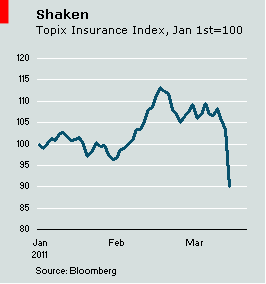
Disaster modelling firm AIR Worldwide predicts that insured property losses will range between US$15bn and US$35bn. Any result in this range will dwarf the insured losses that stemmed from the last large quake in Japan, the 1995 Kobe temblor that cost the insurance industry US$3.5bn, according to Swiss Re.
Japan’s insurance industry is dominated by domestic firms, so they will take a large share of the losses—up to US$7.2bn, according to Moody’s. Shares of Japanese insurers plunged today, the first full trading session since the quake. Many commercial risks, however, are passed on to international reinsurers, who also face daunting costs. Following the series of natural disasters in Australia and New Zealand in recent months, the talk is now of a potential end to the long-running soft market. To the extent that a silver lining can be found amidst the tragedy, this could be positive for brokers.
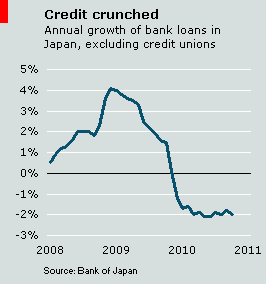 “The recovery seems to be pausing”. In its latest monthly economic report, Japan’s central bank strikes a sombre tone. The latest data from the country’s banks, published a day later, will offer little encouragement.
“The recovery seems to be pausing”. In its latest monthly economic report, Japan’s central bank strikes a sombre tone. The latest data from the country’s banks, published a day later, will offer little encouragement.
Following a 2% year-on-year decline in October, the outstanding loan balance of Japan’s commercial banks has now fallen for 11 consecutive months. It’s somewhat curious, then, that the central bank also reports that “firms see financial institutions’ lending attitudes as improving”.
The majority of data and analysis at Financial Services Briefing is available only to subscribers. Each week, a small share of content from the service is made available to non-subscribers.

Initial public offerings are typically celebratory events. That wasn’t necessarily the case at Dai-ichi Life, a Japanese insurer, even though the company’s US$11bn listing this week was the largest IPO in Japan since NTT DoCoMo went public in 1998.
The move is designed to give the company—Japan’s second-ranked life insurer—the financial flexibility to expand, perhaps by making additional share offerings. Although it operates in Asia’s largest insurance market by far, prospects aren’t bright for life insurers in Japan. The company’s recent financial results make for dire reading and interest among foreign investors in the IPO was subdued.
Dai-ichi already has minority stakes in life insurers in fast-growing Vietnam, Thailand and India. If the company is serious about foreign expansion it needs to act fast, as many western insurers have been expanding their footprints in emerging Asia for some time. Recent deals in the region by America’s MetLife and Britain’s Prudential have also solidified their positions there.
Read more at Financial Services Briefing: “Listing southward” (March 24th)
In these credit-constrained times, it seems odd to welcome news of a fall in bank lending. But that’s what’s happening in Japan, where new data on bank loans was released today.
In December, loans at domestic Japanese banks fell for the first time in four years. This is being interpreted as a sign of recovery in the capital markets, as companies find it easier to raise money via bonds instead of relying solely on bank loans and credit facilities. However, as the FT points out, the thawing of credit markets appears to benefit large companies most of all, with smaller firms continuing to bemoan bleak financing conditions.
